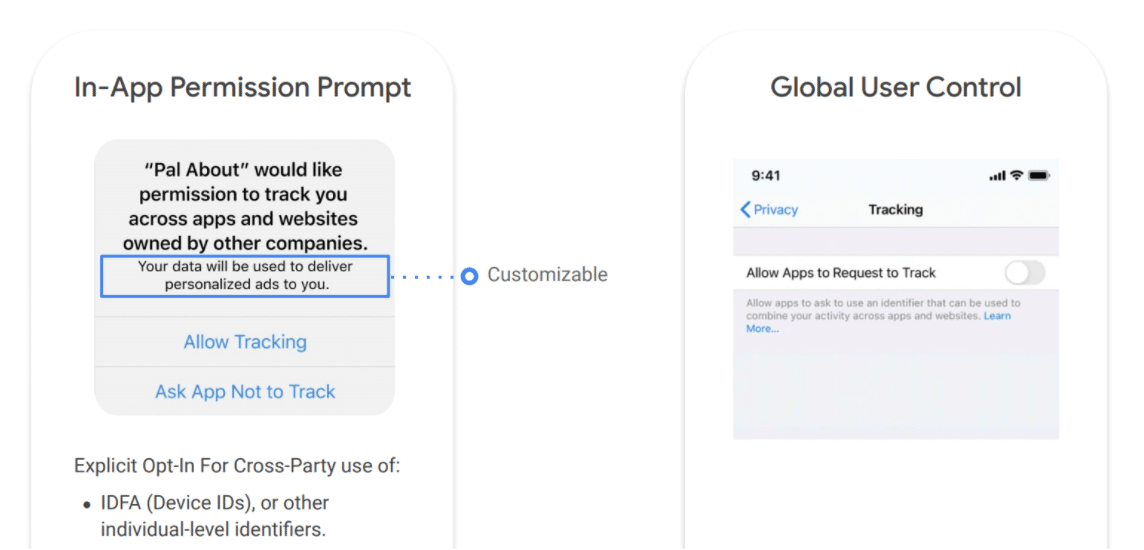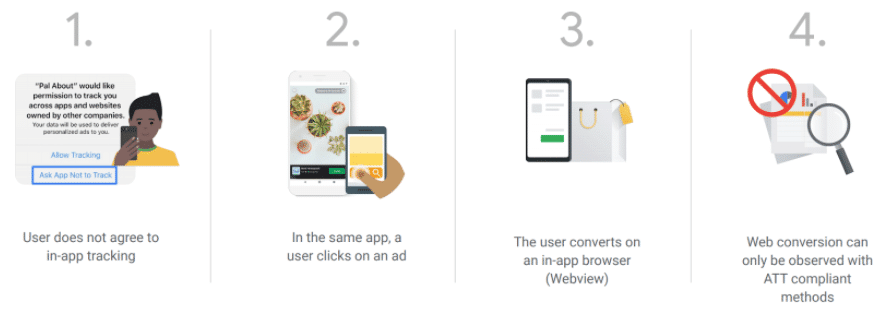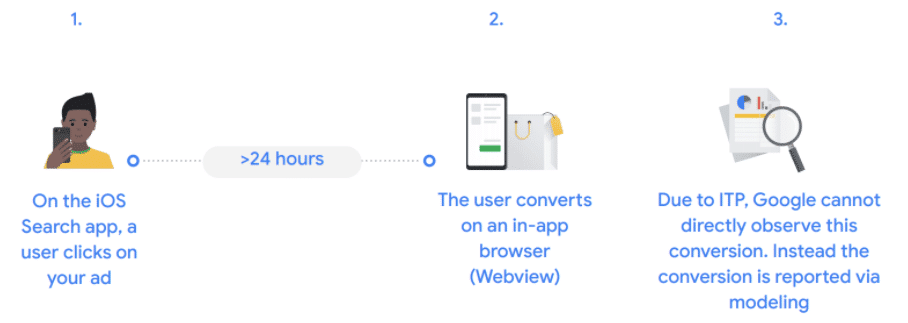iOS14 Updates
Apple recently introduced new privacy and security features for their iOS14 software update. As a result, Google, Facebook, and other digital advertising platforms have had to make significant updates to products to comply with the new privacy and security features. This update is largely focused on user privacy within apps, so Google’s updates were less significant than Facebook’s, and will affect App Campaigns, Interest-Based Targeting, and Remarketing Audience Sizes.
What’s Changing
Apple called out three significant changes that will take place in the new update:
- App Tracking and Transparency (ATT): this is a new policy requirement in which developers will need to request explicit permission from a user to “track” their usage across apps and websites owned by other companies.
- This will take form as an In-App permission prompt, as well as globally from the settings section of an Apple product.
Image Credit: Google
- App Privacy Details: Apple introduced new “nutrition labels” for iOS apps that essentially give users more visibility/insight into the information apps are collecting and what that information is being used for.
- ITP (Intelligent Tracking Prevention) Expansion: existing ITP will expand from only covering Safari to now covering all WebKit browsers on iOS, including Chrome.
The ATT update is by far the most significant change advertisers will need to be aware of, however, the ITP update also has significant implications for app-to-web conversion tracking.
Implications
The ATT and ITP expansion changes will have the largest impact on App Campaigns, specifically when tracking app-to-web conversions. Although this may seem like an enormous hurdle for digital advertisers, an ongoing study by Flurry, an app analytics company, showed a range from 3-16% Opt-In rate worldwide. These charts are being updated weekly and should help give advertisers some insight into how consumers are reacting to these privacy changes.
Let’s look at an ATT example: if a user doesn’t agree to app tracking then clicks an ad within that app, and converts on an in-app browser, the conversion won’t be attributed to that App Campaign. The only way for that conversion to be attributed to the App Campaign is if the user agrees to the ATT notification. Google provides a great visualization of this situation:
Image Credit: Google
The Intelligent Tracking Prevention (ITP) expansion will also cause issues when tracking App-to-Web conversions. For example, if a user searches for something on the iOS Search app, clicks on your ad, but doesn’t immediately convert and instead converts via an in-app browser 24 hrs later, then this conversion can’t be directly attributed to that App Campaign and will be reported via modeling instead.
Image Credit: Google
Additionally, and perhaps most importantly, advertisers will lose the ability to track individual people, their age, gender, parental status, and many of the actions they take on the websites they browse. This will result in a substantial loss in data around interest-based targeting within Google. While this won’t affect Search Campaigns, Display, Discovery, and Youtube Campaigns that leverage interest-based targeting will likely see a decrease in performance as Google’s ability to target people by past behavior becomes more limited. We will also likely see a decrease in remarketing audience sizes and Customer List match rates as more Apple users take advantage of the updated privacy settings.
How Can Advertisers Prepare
While these changes may seem daunting at first, there are a few ways advertisers can prepare for these changes.
- Migrate App Campaigns off tROAS (target ROAS). Google expects App Campaigns that leverage the tROAS bid strategy will be affected the most once Apple begins to enforce these updates. To combat the potential lack in conversion tracking, Google recommends advertisers leverage the Target CPA (tCPA) bid strategy which should help scale campaigns and drive more stable performance.
- Customize the ATT prompt (if applicable). The goal of a customizable ATT prompt is to improve Opt-In Rates by helping your users understand what their data is being used for. Contrary to some consumer beliefs, opting out of the ATT prompt doesn’t limit the number of ads that will be shown, but does decrease the relevancy of ads. This article from Kochava (a data attribution company) highlights a few of the best practices around maximizing user opt-in rates.
- Implement the global site tag. Site-wide implementation of the global site tag (gtag.js or Google Tag Manager) will improve the measurement of app-to-web conversions. If you’re not already leveraging Google Tag Manager, doing so will help navigate future ecosystem changes, and ensure your 1st party data is being tracked appropriately. Check out this article for some additional info on implementing a global site tag.
- Focus on gathering as much first-party data as possible. The more advertisers can rely on their own data, the less they will be affected by these privacy changes. This can be done through forms on your website or app, email lists, surveys, social media, and other first-party data acquisition methods. Due to the increased importance of first-party data, Google recently put out a great article on key ways to create value with first-party data.
- Leverage your first-party data to create Customer Lists and Lookalike/Similar Audiences. By uploading your first-party data in your advertising platforms to create lookalike audiences, you are reducing your reliance on interest-based targeting and shrinking pixel-based remarketing audiences. There are many ways to segment first-party data, so before lumping all of your customers into one audience, consider what those people did on your site: what content did they download, what products did they purchase, etc… This will help refine your lookalike audiences and result in a more targeted approach than simply serving ads to people that are similar to ALL of your customers. For more info on Similar Audiences in Google, check out this help article.
Given the wide range of impacts these privacy policy updates will have on digital advertising, it is imperative that advertisers have a comprehensive understanding of how these changes will affect the various campaign types within Google, as well as the best ways to prepare for a world with less access to user-specific data. As these changes start to become increasingly more noticeable within digital campaigns, we highly recommend leveraging the optimizations highlighted above. That said, digital advertisers need to get used to these types of privacy updates as consumers become more and more aware of their digital data and how it is used. We are likely to see a slew of data privacy laws implemented across the US as the rest of the country follows in California and Europe’s footsteps.



